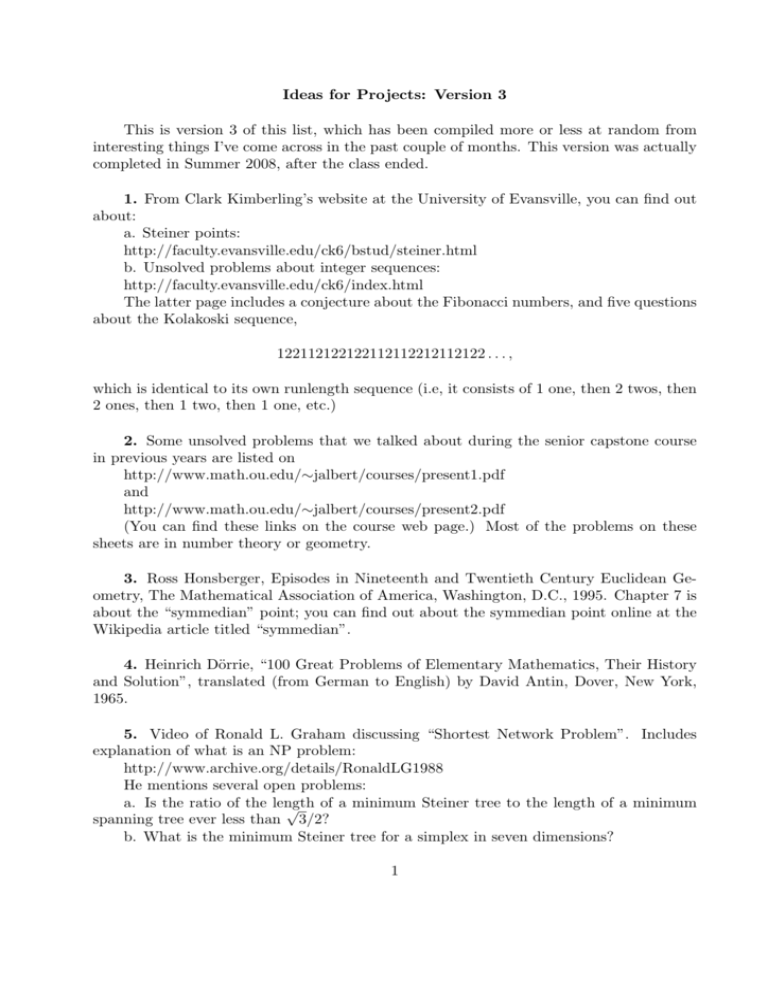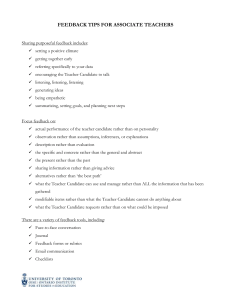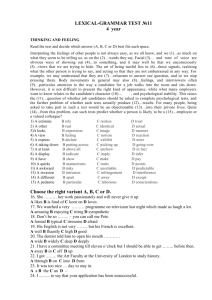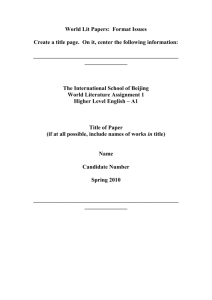list of possible ideas for presentations
advertisement

Ideas for Projects: Version 3 This is version 3 of this list, which has been compiled more or less at random from interesting things I’ve come across in the past couple of months. This version was actually completed in Summer 2008, after the class ended. 1. From Clark Kimberling’s website at the University of Evansville, you can find out about: a. Steiner points: http://faculty.evansville.edu/ck6/bstud/steiner.html b. Unsolved problems about integer sequences: http://faculty.evansville.edu/ck6/index.html The latter page includes a conjecture about the Fibonacci numbers, and five questions about the Kolakoski sequence, 122112122122112112212112122 . . . , which is identical to its own runlength sequence (i.e, it consists of 1 one, then 2 twos, then 2 ones, then 1 two, then 1 one, etc.) 2. Some unsolved problems that we talked about during the senior capstone course in previous years are listed on http://www.math.ou.edu/∼jalbert/courses/present1.pdf and http://www.math.ou.edu/∼jalbert/courses/present2.pdf (You can find these links on the course web page.) Most of the problems on these sheets are in number theory or geometry. 3. Ross Honsberger, Episodes in Nineteenth and Twentieth Century Euclidean Geometry, The Mathematical Association of America, Washington, D.C., 1995. Chapter 7 is about the “symmedian” point; you can find out about the symmedian point online at the Wikipedia article titled “symmedian”. 4. Heinrich Dörrie, “100 Great Problems of Elementary Mathematics, Their History and Solution”, translated (from German to English) by David Antin, Dover, New York, 1965. 5. Video of Ronald L. Graham discussing “Shortest Network Problem”. Includes explanation of what is an NP problem: http://www.archive.org/details/RonaldLG1988 He mentions several open problems: a. Is the ratio of the length √ of a minimum Steiner tree to the length of a minimum spanning tree ever less than 3/2? b. What is the minimum Steiner tree for a simplex in seven dimensions? 1 c. Circle conjecture: the minimum Steiner tree for points around the boundary of a circle is just formed by connected the points and throwing away the edge with longest arc length. d. It’s not known whether the problem of deciding whether the length of the minimum spanning tree is less than a given integer L is NP-complete (even though the minimum spanning tree can be found in polynomial time!) e. The P=NP problem. and gives the reference: M.R. Garey and D. S. Johnson, “Computers and intractibility: a guide to the theory of NP-completeness”, W. H. Freeman and Co., 1979 The Wikipedia article on “Steiner tree” has some good references too, including a 1992 book by F.K. Hwang, D.S. Richards, and P. Winter. See also the article on “Jakob Steiner”. Ronald Graham is the husband of Fan Chung. Both of them are eminent mathematicians. See their interesting web pages at http://math.ucsd.edu/∼fan/ and http://math.ucsd.edu/∼fan/ron/ . One bit of trivia about Ronald Graham is that he holds the record for the largest number ever used in a mathematical proof. 6. A good article about the twin primes conjecture is: “Are there infinitely many twin primes?” by Daniel Goldston, at www.math.sjsu.edu/ goldston/twinprimes.pdf . 7. The Wikipedia article on “Polygon” has some interesting stuff. 8. The book “Geometry and Billiards” by Serge Tabachnikov is written for undergraduates, and is available free online at http://www.math.psu.edu/tabachni/Books/billiardsgeometry.pdf 9. The book “Miles of Tiles” by Charles Radin had this review at amazon.com: “This book can’t miss,—*not with a title like that!* And it *is* a hit!— Perhaps few math books are hits in the corner-book store, or at amazon. In this case, my undergrad students, and the grad students too!, — reacted very positively. And they aren’t easy to please! This lovely little book also worked great when I tried it in an individual undergrad research project. —What does the old positional number system (the one we all learned in school)— have to do with dynamics,— or with various ‘mystery-tiles’, pinwheel tilings...? Look!! It is in the book! (Hint: They all come about by clever manipulation of the letters in a finite alphabet, or the chosen ‘digits’ in our familiar number system.) These manipulations follow rules, and they come from specifying a matrix. Then the more abstract tools from mathematical analysis, and ergodic theory, enter when second generation dynamical systems, (abstractions if you will!)— are built on ‘spaces’ of all tilings in a given class,— or on a specified variety of outcomes in symbolic dynamics. We then arrive at iterated matrix operations, and limits: We must solve associated eigenvalue problems. Take limits, and if you are careful, you find equilibrium states which represent solutions 2 to otherwise intractable puzzles,— from math (for example, familiar, or unfamiliar, completions of number systems),— and from applications to real life problems, familiar,— or perhaps unexpected, tilings. Useful ones!” 10. Problems in combinatorics: (I’m not sure which of these books are available at the OU Library). a. “Basic techniques in combinatorial theory”, by Daniel I. A. Cohen, Wiley, 1979. b. “Combinatorics”, by N. Ia. Valenkin c. “Combinatorics, a problem-oriented approach”, by D. Marcus d. “A course in enumeration”, by Martin Aigner. Online at http://www.springerlink.com/content/g15633/ (obtained through Bizzell). e. “Mathematical problems and proofs. Combinatorics, number theory, and geometry”, by Branislav Kisacanin f. “Counting: the art of enumerative combinatorics”, by George E. Martin. g. “102 Combinatorial problems”, by Titu Andreescu and Zuming Feng 11. There is a wealth of interesting material (not limited to computer science, despite the title) in “Concrete mathematics : a foundation for computer science” by Ronald L. Graham, Donald E. Knuth, Oren Patashnik. 12. Two journals in which undergraduates publish results of their mathematics research projects are: a. Furman University Journal of Undergraduate Mathematics, online at http://math.furman.edu/ mwoodard/fuejum/content/toc.html and b. Rose-Hulman Undergraduate Math Journal, online at http://www.rose-hulman.edu/mathjournal/index.php 13. The following is taken from http://www.ovaryresearch.com/email.htm (referenced in the NY Times on Jan. 22, 2008 at http://well.blogs.nytimes.com/2008/01/18): “CA-125 is NOT an Effective Screening Test for Ovarian Cancer? ALL the existing studies tell us that CA-125 is NOT a good screening test for ovarian cancer. The CA-125 blood test measures a protein in the blood which is produced by normal cells, as well as by cells from common non-cancerous conditions such as endometriosis, fibroids, benign ovarian cysts, pelvic infections, pregnancy, and normal menstrual periods. Non-gynecologic conditions such as liver disease and inflammatory diseases as well as a variety of other cancers also elevate the CA125 levels. For a screening test to be helpful, it must detect disease in individuals who feel entirely well, at a time when the disease is in its earliest and most curable stages. To be helpful, a screening test must be extremely accurate. For example, even a test that is 99.6% accurate will find 1 woman with the disease, but also will falsely inform 9 women that they have the disease when they do not (false positives). 3 For postmenopausal women who have an elevated CA-125 level, most will NOT have ovarian cancer. The test is even less accurate for women prior to menopause. And, in women who do have early ovarian cancer, (those women we need to find since ovarian cancer is still highly curable) the CA-125 levels will be normal in at least 50%. If 10,000 women aged 50 - 64 are screened with CA-125 testing for ovarian cancer yearly, 300 women will test positive and require further evaluation. Twenty-four of these women will need surgery, 20 of whom will not have ovarian cancer and, therefore, be subjected to unnecessary surgery with inherent risks and recovery. Only 4 of the 10,000 women will have ovarian cancer. Similarly discouraging results are found with screening by ultrasound of the ovaries in asymptomatic women.” Explain the statement that “even a test that is 99.6% accurate will find 1 woman with the disease, but also will falsely inform 9 women that they have the disease when they do not (false positives).” (Hint: you’ll need to use the information in the last paragraph of the excerpt.) This is a simple exercise we might do in class, but it does raise the question of how best to communicate statistical results. See also: a. http://www.ajronline.org/cgi/content/full/187/2/271 (Fundamentals of Clinical Research for Radiologists — Meta-Analysis of Diagnostic and Screening Test Accuracy Evaluations: Methodologic Primer) b. http://www.rapid-diagnostics.org/accuracy.htm c. http://bmj.com/cgi/reprint/324/7341/824.pdf (Communicating accuracy of tests to general practitioners). 14. Benford’s law: why do most numbers obtained from measurements start with 1? Which data sets will follow this law? (Not all will: for example winning lottery numbers generally have an equal chance of beginning with each of the 9 digits). See http://www.physorg.com/news98015219.html and http://www.iop.org/EJ/abstract/0143-0807/28/3/N04 (or http://www.iop.org/EJ/article/0143-0807/28/3/N04/ejp73n04.pdf, ¯¯ or http://stacks.iop.org/EJP/28/L17) 15. Researchers conjecture that least-energy configurations of discs (I think) on a cone lie in Fibonacci spirals, and provide some experimental evidence with microstructures. a. http://www.physorg.com/news97227410.html b. Li, Chaorong, Ji, Ailing, and Cao, Zexian. “Stressed Fibonacci spiral patterns of definite chirality.” Applied Physics Letters 90, 164102 (2007). c. Li, Chaorong, Zhang, Xiaona, and Cao, Zexian. “Triangular and Fibonacci number patterns driven by stress on core/shell microstructures.” Science 309, 909 (2005). 16. The Tammes problem asks: how can we arrange n points on the sphere so as to make sure each pair of points is as far apart as possible? The answer remains unknown for all but a few values of n. This problem is relevant to coding theory (how to send a message efficiently with the least likelihood of making errors) and to the structure of virus coats. 4 A related problem is Thompson’s problem: given that electrons repel each other according to a certain law, how will n electrons arrange themselves on the surface of a sphere? A fun tool for exploring this question is online at http://physics.syr.edu/thomson/thomsonapplet.htm There is a theoretical discussion of these problems at http://users.ipfw.edu/dragnevp/Sigma Xi1.ppt ¯ 18. The Fibonacci sequence starts from the numbers 1, 1 and proceeds to add new numbers by adding the last two numbers written down. What would happen if, at each step, we flipped a coin to decide whether to add the last two numbers or subtract the last number from the one before it? For some answers, see “Fibonacci at Random: Uncovering a new mathematical constant”, by Ivars Peterson, at http://www.sciencenews.org/pages/sn arc99/6 12 99/bob1.htm ¯ ¯ ¯ Peterson’s article explains work presented in “Random Fibonacci sequences and the number 1.13198824 . . . ” by Divakar Viswanath, which is online at http://www.ams.org/mcom/2000-69-231/S0025-5718-99-01145-X/home.html This question turns out to be related to a celebrated theory of random matrix multiplication due to Furstenberg and Kesten, which has been used, among other things, to explain why glass is transparent. 19. A couple of problems listed in J. S. Kelly’s “Conjectures and Unsolved Problems” column, which appeared in the journal Social Choice and Welfare in the 1980’s, concern Condorcet winners and the Ostrogorski paradox. Sometimes in simple majority voting with n candidates, if each of m voters votes according to a fixed order of preference of the candidates, there is no candidate who can beat every other candidate: e.g., candidate x loses to candidate y, candidate y loses to candidate z, and candidate z loses to candidate x. When this happens we say there is no Condorcet winner. The unsolved question is what proportion of possible elections result in there being no Condorcet winner. The Ostrogorski paradox refers to the possibility that if, in an election among various candidates, each voter votes for the candidate with whom he agrees on the most issues, a candidate who disagrees with the majority of the voters on every issue can actually defeat a candidate who agrees with the majority of the voters on every issue. Here the unsolved problem is again a question of proportions: how likely is this situation to occur in an election? The references are: “Conjectures and Unsolved Problems: 1. Condorcet Proportions,” Social Choice and Welfare, Vol. 3, No. 4 (December, 1986) 311314; and “Conjectures and Unsolved Problems: 6. The Ostrogorski Paradox,” Social Choice and Welfare, Vol. 6, No. 1 (January, 1989) 7176. 20. A key problem in computer science is that of finding the longest increasing subsequence of a given finite sequence of numbers. For a discussion of its importance and relevance to various other interesting problems, see: http://bit-player.org/2006/san-antonio-alternating-subsequences 5 or the article “Longest increasing subsequences: from patience sorting to the Baik-DeiftJohansson theorem” by D. Aldous and P. Diaconis in the Bulletin of the American Matematical Society, vol. 36 (1999), 413–432. As the latter article points out, the problem is related to a strategy for winning a certain type of solitaire game. You might also check out the analysis of the most common solitaire game (the one that comes with Microsoft Windows) in the paper “Solitaire: Man vs. Machine” by Xiang Yan et al., available at: http://www.stanford.edu/∼bvr/psfiles/solitaire.pdf 6









